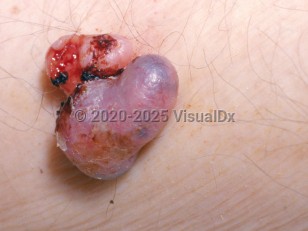Two to five million eccrine glands are distributed on almost the entire skin surface, with sparing of the lips, external auditory canal, glans penis, labia minora, and clitoris. Eccrine gland carcinoma can arise de novo in a normal sweat gland structure, or it can represent a transformation of a pre-existing benign eccrine neoplasm. It tends to occur in the fifth through eighth decades of life. It typically presents as a solitary, asymptomatic lesion, most commonly on the head and extremities and less often on the trunk. There may be ulceration or bleeding. There are reports of rapid growth to larger than 1 cm within a few months, as well as slow growth over several years. Some patients report a rapid burst of growth from a previously stable papule, plaque, or nodule.
The pathogenesis of these sweat gland neoplasms is not well understood. Immunosuppressed patients may be more susceptible to developing both benign and malignant eccrine neoplasms. Unlike squamous cell carcinoma and basal cell carcinoma, there is not a firmly established role for ultraviolet (UV) radiation and environmental toxins in eccrine carcinoma. This may be because the cutaneous appendages are relatively protected from these mutagens by their deep dermal location. However, some studies have entertained a causal role for both UV radiation and genetics in microcystic adnexal carcinoma, one type of eccrine carcinoma.
Eccrine gland carcinomas can be locally invasive, but most pose a low risk for metastasis. There are isolated reports of metastatic eccrine carcinomas, but these represent the minority of cases.
The classification of cutaneous sweat gland adnexal lesions is shown below with the corresponding benign precursors:
- Poroma (benign) – porocarcinoma (malignant)
- Hidradenoma (benign) – hidradenocarcinoma (malignant)
- Spiradenoma (benign) – spiradenocarcinoma (malignant)
- Cylindroma (benign) – cylindrocarcinoma (malignant)
- Syringometaplasia (benign) – syringoid carcinoma (malignant)
- Syringofibroadenoma (benign) – mucinous carcinoma, adenoid cystic carcinoma, and digital papillary adenocarcinoma (malignant)
- Mixed tumor (chondroid syringoma; benign) – malignant mixed tumor



